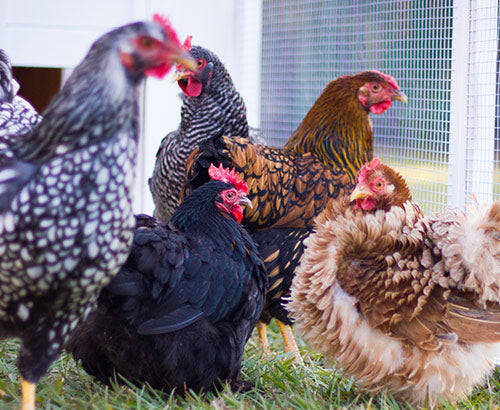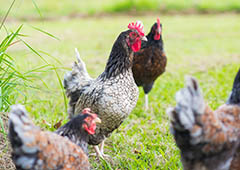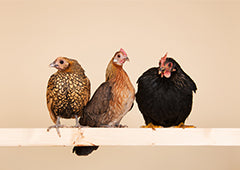Fine cuisine, great art and beautiful music are just a snapshot of the cultural influences from life in nineteenth century Italy. Enter the Ancona chicken. Originally bred in the Marche region of the central east coast of Italy, this stunning breed takes its name from the seaport city of Ancona. For centuries these Italian beauties thrived in their homeland before being discovered by poultry enthusiasts in England in the mid - 1800s and a little later on in the United States.
Striking Beauty
The Ancona is one of the most striking chicken breeds. Astonishing orange-red eyes peak out from behind their signature midnight black feathers whose tips are marked with bright white v-shaped speckles. They certainly stand out in a crowd of chooks. These speckles have a very specific design though -- only 1/3 of the feathers are tipped in this way. And, even more interesting, you’ll easily be able to spot your senior chooks because the white tips grow larger following each moult. Simply fascinating!
A true Mediterranean breed, the Ancona sports feathers that hug their body tightly, clean legs, light coloured skin (typically white or pale yellow) and white earlobes. Their bright yellow legs and upper beak are streaked with black. Other not so common varieties are the Blue and Red Ancona, both with white speckled feathers.
Though a single comb is much more common, these beauties can also have rose combs. Hens with single combs will most likely be found primping in front of a mirror as they struggle with bad comb days – the female’s single comb typically flops over to the side.
Beauty is in the eye of the eggs-ibition judges as these beauties make exceptional show birds. Perhaps you want to try your hand at showing your chooks. Your Anconas just may steal the show with their dazzling looks.
Chicks are breathtaking! With a lovely blend of black and yellow feathers – black on back and fuzzy yellow bellies underneath – they almost look as if they’re donning a little black cape. Have superhero chick cape, will fly…well, not quite yet! They’ve got quite a bit of growing up to do, but these birds do mature early.
Egg-ceptionally Loyal Layers
It is believed that Anconas were originally bred with some of the first Leghorns and other egg-cellent layer breeds, so it’s no wonder these chickens are highly productive layers of large white eggs. Hens are known to lay approximately 220 eggs per year. These loyal layers are quite hardy and go above and beyond the pleasant typical egg laying weather and are famous for continuing to lay into the colder winter months. So, while the Ancona hen is not as prolific of a layer as her relative the Leghorn, she is a regular layer.
This egg-straordinarily fertile breed will definitely bless you with a great opportunity to raise chicks. However, even though Ancona ladies may pop out eggs like CrAzY, these gals are busy as bees – scratching, foraging and clucking the day away – so, you definitely won’t find these gals plopped on the nest. So, if it’s baby chicks you want, you’ll need to either place the fertilized eggs in an incubator or invite a more motherly gal to set on the nest.
On the plus side, lots of eggs means lots of delicious egg dishes.
Active and Entertaining
Anconas are active, playful, talkative and just plain entertaining! Busy from sun up till sundown, this unique breed doesn’t typically do well when confined. No worries, though. Backyard Chicken Coops has the ideal coops for these happy-go-clucky birds – with LOTS of room to flap and roam, Anconas will never feel “cooped up”.
Thankfully these lively chatty chooks also get along well with other chooks, chatty or otherwise. And, if raised in a loving caring environment, Anconas can develop a nice trusting relationship with their human families and do become quite tame.
Do you enjoy lively conversation? Are you someone who thrives on keeping active? Well, then you’ve found some feathery kindred spirits in the Ancona breed. Although Anconas may just talk your ear off, there definitely won’t be any awkward lull in the conversation.
Economical
Everyone wants to save money. That’s a given. Ancona chickens to the rescue! Whether you have a whole flock of these feathery black beauties or just a few, these chooks are egg-ceptional foragers.
Excellent foragers translates into excellent feed conversion. In essence, feed conversion simply means the amount of feed necessary to produce a specific outcome, e.g. eggs for laying hens. So, the more seeds, grains, grasses, etc. that Ancona chickens peck while free ranging, the less feed overall they’ll need to consume. Anconas are also smaller chickens right from the start with adults weighing in at just under 3 Kg for males and 2.5 Kg for females and smaller chickens eat smaller amounts of feed. So little feed, so many eggs! And, there’s also a bantam variety of the Ancona chicken. Cluck about economical – these compact yet bold Ancona chooks are definitely worth your while.
Fantastic Flyers
Anconas are fantastic flyers. Now while most backyard chicken keepers pretty much frown on their beloved chooks taking flight and fleeing the coop, there is definitely a method to this flighty madness. Anconas, by design, are exceptionally alert birds and are highly in tune with their surroundings. This makes these chooks first rate protectors of your precious flock. In fact, they were originally bred to fly from danger in order to protect themselves from predators. So, if your backyard or neighborhood is home to a host of air and land predators, Ancona chickens are up for the challenge. These superhero feathery sentries are happy to be on guard duty.
The Ancona chicken is definitely a must have for your backyard flock. If only to add a bit of pizazz and style to your flock, these dazzling black beauties will be the talk of the coop, neighborhood and even the whole town. They certainly are lovely, lively and loyal.
And, housing these busy beauties is as easy as 1, 2, 3! Or, the Taj Majal, the Penthouse and the Mansion chicken coops. You’ll fall head over heels in love with the Ancona’s antics as they flap the day away in these innovative and stylish chicken houses. Most importantly, our coops are the perfect fit for these busy as a bee foragers – our runs go above and beyond minimal space requirements to match the above and beyond personality of the amazing Ancona chicken.
Before choosing your dream coop, consider what other breeds may fit perfectly into your flock family. Deciding to become a chicken parent is the easy part. The hardest is deciding which breed is most suitable for you. It can be eggtremely confusing and difficult – so where should you begin?
Cluckily, our friends over at Chickenpedia have created an amazing Chicken Breeds Course. This extensive online course shares useful advice on choosing the right chickens for you as well as size & frequency of eggs laid. You’ll even learn about their individual personalities, and be able to use their family-friendly compatibility scale through this well-structured program. It really is a great way to find your perfect backyard buddies which is why I highly recommend them to all of my readers! The courses are beginner-friendly and filled with vital information to help you raise a happy, healthy flock.
As chicken keepers, we want to do an eggcellent job when caring for our feathered friends, but many of us struggle to handle chicken health or behavior issues, especially in the first few years of having a flock. Chickenpedia have a full range of comprehensive online courses that cover everything you didn’t know you need to know and then some more! From healthcare to raising baby chicks to feeding and behavior, that’ll give you the knowledge and confidence to successfully look after your chickens.
As a member, you will get access to ALL their fantastic courses. So, no need to wing it, become a confident chicken keeper. Click here to check out Chickenpedia today!


















